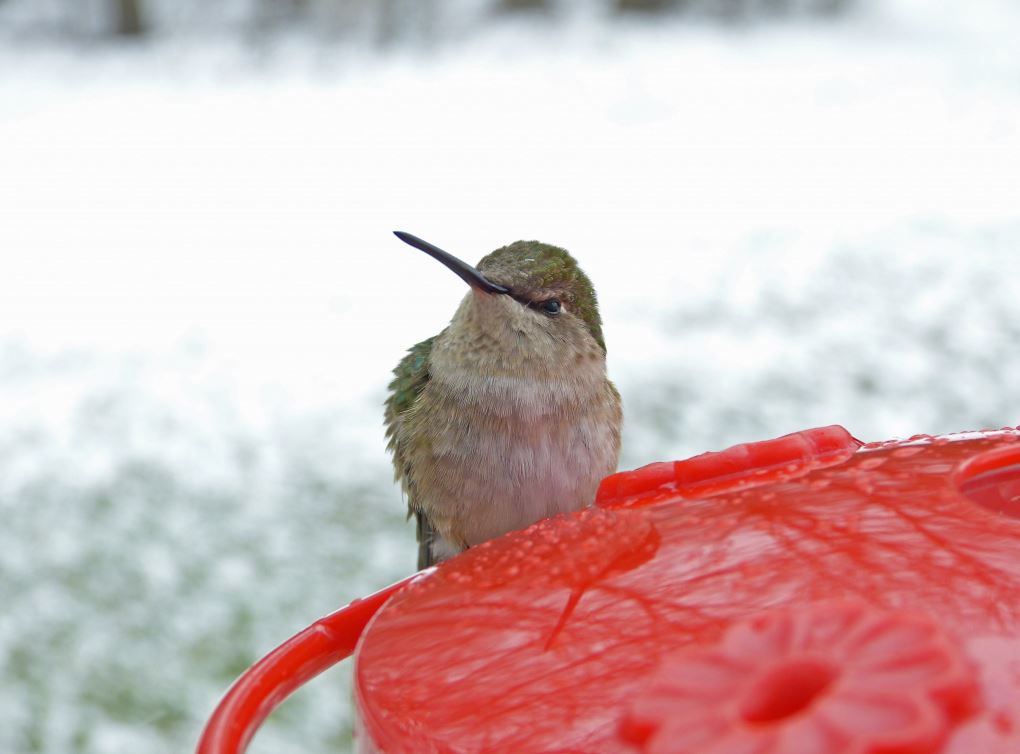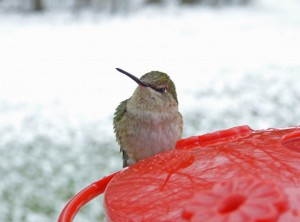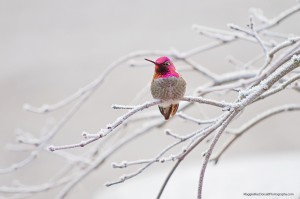How Long Do Ruby Throated Hummingbirds Live
Ruby-throated Hummingbirds: Wintering due north at a nectar feeder almost you lot?
December 22, 2015

Thank to Lauren Flesher for this guest pupil blog mail service. Lauren describes how Cherry-red-throated Hummingbirds are expanding their winter range into the southeastern U.s..

photo © Bob Vuxinic
Hummingbirds, with their small size, striking colors, vivid iridescence, and rapid hovering flight, are frequently thought of every bit flying jewels. Scarlet-throated Hummingbirds, found throughout eastern N America, are especially beloved past lawn birdwatchers. But past winter, most hummingbirds will take left their nectar feeders behind, having migrated south to Key America and Mexico. In fact, Crimson-throated Hummingbirds are known for their astonishing migration across the Gulf of Mexico, a 500-mile journey that takes 20 hours of non-stop flight. That's quite a feat for a bird that only weighs a few grams! But over the concluding 25 years, some hummingbirds have found a way to avoid that strenuous flight by wintering in the warmer parts of the southeastern Us. The wintering range of the Ruby-throated Hummingbird has expanded dramatically in the last several decades with the range shifting nigh 200 miles north. These hummingbirds can now reliably be found in winter from the Gulf Coast states up the Atlantic Declension to South Carolina.

To better understand the wintertime ecology of these hummingbirds at the northern edge of their new wintertime range, researchers intensively studied birds in 1 South Carolina backyard. They studied the birds passing through and wintering in the area for four years, gathering data on age, sex, and frequency of return. The research team banded 416 hummingbirds with minuscule identification rings, each with a specific sequence of numbers, so that private birds could be identified. At the stop of the study period, the researchers had accumulated interesting results.
The likelihood that an individual would return to the study site for more than than one winter was about xix%, a higher return rate than what had been previously documented at written report sites further south. Amidst females, the return rate was even greater, reaching more than 31%. Some individuals returned every winter during the study menses, while others returned only in one case or twice. None of the hummingbirds nowadays during the winter lived in the area during the summertime, suggesting that the summertime residents had migrated south and the winter residents were from breeding populations farther northward. Furthermore, during winter more males than females were present, especially amid juvenile birds. This suggests that unlike sexes and ages winter in different places, a strategy used past many bird species, just a blueprint non previously documented in Reddish-throated Hummingbirds.

photo © Maggie MacDonald
The researchers predict that wintering Crimson-throated Hummingbirds will go on to motion farther n as the climate continues to warm. Wintering closer to their breeding grounds not but increases their chances of surviving migration, but besides allows them to commencement convenance sooner. Who knows? Maybe in a few decades nosotros'll never have to spend a winter without hummingbirds.
You can aid study wintering hummingbirds by signing up for Project FeederWatch and counting the birds that visit your yard.
Reference: Cubie, D. 2014. Site Fidelity, Residency, and Sex Ratios of Wintering Cerise-throated Hummingbirds (Archilochus colubris) on the southeastern U.Due south. Atlantic Coast. The Wilson Journal of Ornithology 126: 775-778.
Lauren Flesher is senior at Cornell University studying sustainable agriculture. Her area of study includes the development of methods for avian conservation in agroecosystems, and the mitigation of avian pest harm.
<< Return to blog habitation
Source: https://feederwatch.org/blog/ruby-throated-hummingbirds-wintering-northward-at-a-nectar-feeder-near-you/
Posted by: brownthabould.blogspot.com

0 Response to "How Long Do Ruby Throated Hummingbirds Live"
Post a Comment